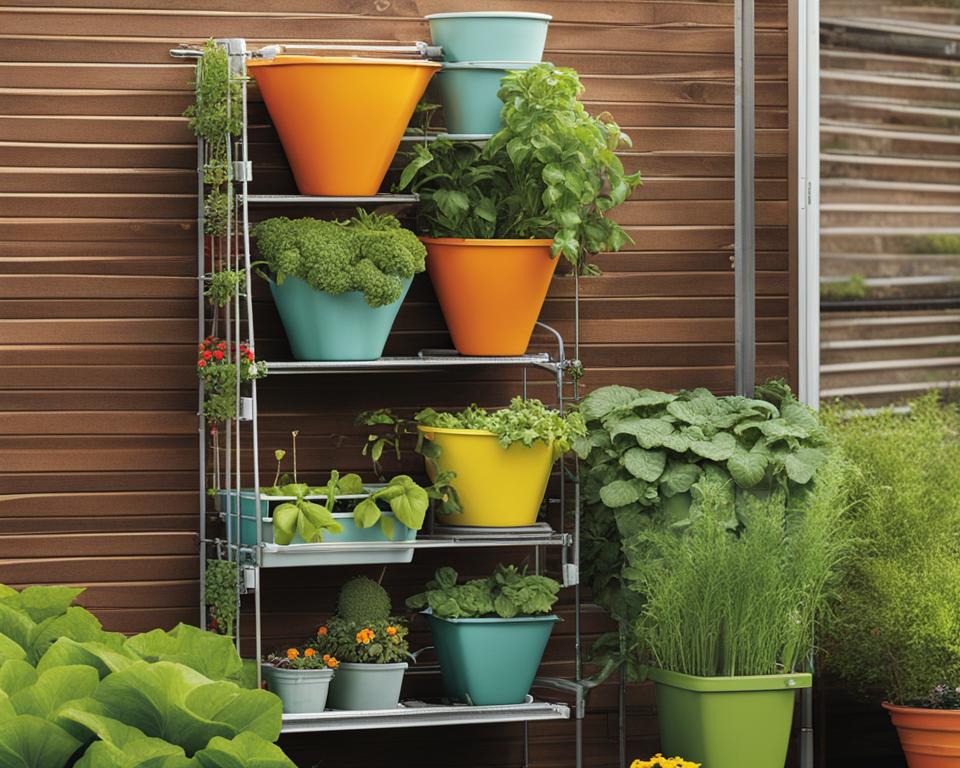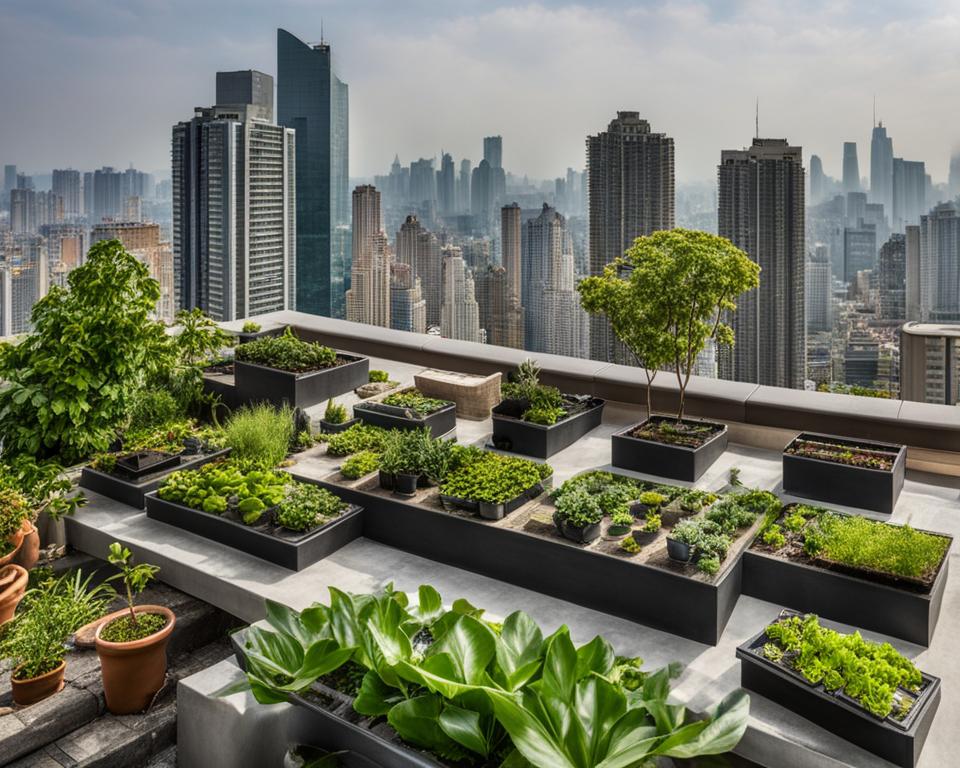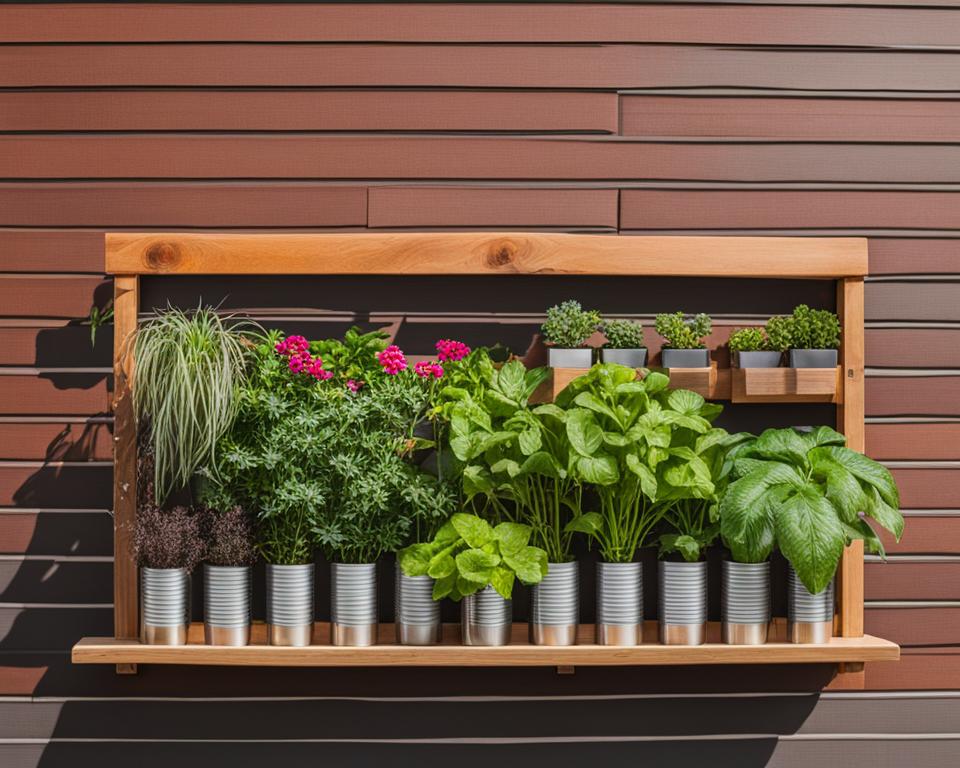Urban gardening is a growing trend among space-starved individuals who want to grow their own food and create a green oasis in the city. With the right tips and products, anyone can master the art of urban gardening and make the most of their limited space. From choosing the right plants to utilizing innovative gardening techniques, there are plenty of ways to create a thriving urban garden.
Key Takeaways:
- Urban gardening is a popular practice in urban areas with limited space.
- It offers numerous benefits, including access to fresh produce and a greener environment.
- Choose suitable plants and utilize vertical gardening techniques for small spaces.
- Essential products include lightweight containers, tools, and organic fertilizers.
- Urban gardens can take various forms, such as container gardens and rooftop gardens.
What is Urban Gardening?
Urban gardening is a practice that allows people to grow plants, flowers, and herbs in urban areas with limited space. It can take on various forms, including community gardens, rooftop gardens, and balcony gardens. Urban gardening provides individuals with an opportunity to reconnect with nature, access fresh produce, and enhance the aesthetics of their surroundings. It is a sustainable and fulfilling way to utilize small spaces and contribute to a greener environment.
What is Urban Gardening?
Urban gardening is a practice that allows people to grow plants, flowers, and herbs in urban areas with limited space. It can take on various forms, including community gardens, rooftop gardens, and balcony gardens. Urban gardening provides individuals with an opportunity to reconnect with nature, access fresh produce, and enhance the aesthetics of their surroundings. It is a sustainable and fulfilling way to utilize small spaces and contribute to a greener environment.
Urban gardening provides individuals with an opportunity to reconnect with nature, access fresh produce, and enhance the aesthetics of their surroundings.
Urban gardening is a practice that allows people to grow plants, flowers, and herbs in urban areas with limited space. It can take on various forms, including community gardens, rooftop gardens, and balcony gardens. Urban gardening provides individuals with an opportunity to reconnect with nature, access fresh produce, and enhance the aesthetics of their surroundings. It is a sustainable and fulfilling way to utilize small spaces and contribute to a greener environment.
Benefits of Urban Gardening
Urban gardening offers a multitude of benefits for those with limited space. One of the primary advantages is the ability to maximize the use of small areas and grow your own food. By harnessing innovative space-saving gardening techniques, such as vertical gardening and container gardening, you can cultivate a variety of plants, herbs, and vegetables right in the heart of the city.
Engaging in urban gardening not only promotes sustainable living but also reduces reliance on store-bought produce. By growing your own food, you have control over the quality and freshness of your harvest, ensuring a sustainable and healthy lifestyle. Additionally, urban gardening can be a source of relaxation and stress relief, allowing you to connect with nature and escape the hustle and bustle of urban life.
Furthermore, urban gardening contributes to the improvement of air quality and enhances the aesthetics of urban areas. Plants act as natural air purifiers, filtering out pollutants and providing fresh oxygen. By incorporating green spaces into the concrete jungle, urban gardening creates a visually appealing and environmentally friendly atmosphere, benefitting both residents and wildlife.
Benefits of Urban Gardening:
- Maximizes use of limited space
- Allows for the cultivation of fresh and nutritious food
- Promotes sustainable living and reduces reliance on store-bought produce
- Provides relaxation, stress relief, and a connection with nature
- Improves air quality and enhances the aesthetics of urban areas
Urban gardening is a rewarding and fulfilling activity, offering a host of benefits for space-starved individuals. With a little creativity and the right techniques, you can transform your small space into a thriving green oasis.
Tips for Successful Urban Gardening
If you’re interested in urban gardening but have limited space, don’t worry! With the right tips and techniques, you can create a thriving urban garden that fits perfectly into your small area. Here are some essential tips to ensure your success:
- Choose plants suitable for small spaces: Opt for herbs, leafy greens, and compact vegetables that don’t require a lot of room to grow. These plants are perfect for balconies, small gardens, or even windowsills.
- Utilize vertical gardening techniques: Make the most of your vertical space by using trellises, hanging planters, or wall-mounted containers. This allows you to grow more plants without taking up valuable floor space.
- Embrace container gardening: Containers are a great option for urban gardening as they are portable and can be easily moved around to optimize sunlight exposure. Make sure your containers have adequate drainage to prevent waterlogging.
- Provide regular care and maintenance: Water your plants regularly and ensure they receive sufficient sunlight. Fertilize them as needed and keep an eye out for pests or weeds that may threaten your garden’s health.
By following these tips, you’ll be well on your way to creating a successful urban garden that not only adds beauty to your space but also provides you with fresh, homegrown produce.
Quotes:
“Urban gardening offers a solution for space-starved individuals to enjoy the benefits of gardening in urban areas.” – Green Thumb Magazine
“Creating a green oasis in the city is not only good for our well-being but also for the environment.” – Urban Gardening Association
Essential Products for Urban Gardening
Urban gardening requires the right products and supplies to ensure success in limited spaces. Here are some essential items that every urban gardener should consider:
- Lightweight and Portable Containers: Opt for pots and planters that are lightweight and portable, making them ideal for small spaces. These containers allow you to easily move your plants around to optimize sunlight exposure.
- Vertical Gardening Structures: Maximize the use of vertical space by investing in trellises and wall-mounted planters. These structures allow you to grow plants vertically, saving valuable floor space.
- Gardening Tools: Essential tools such as hand trowels, pruning shears, and watering cans are a must-have for maintaining your urban garden. These tools make it easier to tend to your plants and keep them healthy.
- Organic Fertilizers and Compost: Provide vital nutrients to your plants by using organic fertilizers and compost. These natural amendments promote healthy growth and sustainable gardening practices.
- Potting Soil: Use high-quality potting soil that is well-drained and nutrient-rich. Good soil is the foundation for successful plant growth in urban environments.
“The right products and supplies can make all the difference in the success of your urban garden. From lightweight containers to vertical gardening structures, investing in the right tools and resources will help you create a thriving green space in the heart of the city.”
Maximizing Space with Vertical Gardening Structures
One of the key challenges in urban gardening is limited space, but vertical gardening structures offer a solution. By utilizing walls, fences, or specially designed structures, you can grow plants vertically, effectively utilizing vertical space that might otherwise go unused. Vertical gardening structures come in various shapes and sizes, from trellises for climbing plants to wall-mounted planters for herbs and flowers. These structures not only save space but also add an interesting visual element to your urban garden.

Types of Urban Gardens
Urban gardening offers a diverse range of options for creating green spaces in limited areas. Whether you have a small balcony or access to a rooftop, there are various types of urban gardens to suit your preferences and available space. Here are some popular urban garden ideas:
1. Container Gardens
Container gardens are perfect for those with limited outdoor space. You can use pots, planters, or even repurposed containers to grow a variety of plants. From herbs and flowers to compact vegetables, container gardens allow you to create a mini oasis right on your balcony or patio. Plus, they are portable, allowing you to move your garden as needed to optimize sunlight exposure.
2. Rooftop Gardens
If you have access to a rooftop, consider transforming it into a thriving garden. Rooftop gardens utilize the available roof space to grow a variety of plants. By using raised beds, vertical structures, and proper irrigation systems, you can create a lush green haven in the heart of the city. Rooftop gardens not only provide fresh produce but also help with insulation, reducing energy consumption and improving the overall environmental sustainability of buildings.
3. Vertical Gardens
Vertical gardens are a creative way to make the most of limited space. By utilizing walls, fences, or structures, you can grow plants vertically, maximizing your garden’s potential. There are various methods for creating vertical gardens, including living walls, trellises, and even hanging planters. Vertical gardens not only add a beautiful aesthetic to your surroundings but also provide additional privacy and improve air quality.
4. Community Gardens
Community gardens are a wonderful way to connect with fellow gardening enthusiasts and foster a sense of community. These gardens bring together individuals in a shared gardening space, allowing them to grow their own produce, exchange gardening tips, and collaborate on larger projects. Community gardens provide an opportunity to learn from experienced gardeners, share resources, and build lasting friendships while contributing to the overall wellbeing of the community.
Regardless of the type of urban garden you choose, the key is to adapt it to your available space and personal preferences. Incorporate elements that resonate with your style and make the most of innovative gardening techniques to maximize your garden’s potential.
Challenges of Urban Gardening
While urban gardening offers numerous benefits, it also presents certain challenges that gardeners need to overcome. Limited space is one of the primary challenges in urban gardening. The size of the garden directly impacts the variety and quantity of plants that can be grown.
Urban environments often face pollution and soil contamination, which can affect the health and growth of plants. Additionally, limited access to sunlight in urban areas can make it challenging to create an optimal growing environment for certain plants.
Pests, such as insects and rodents, can also pose a threat to urban gardens. These pests can damage plants, eat the produce, and undermine the overall health of the garden. Therefore, pest control measures need to be implemented to protect the plants and ensure their well-being.
Overcoming the Challenges
Despite these challenges, there are ways to overcome them and create a thriving urban garden. Here are some strategies:
- Maximize space utilization by implementing vertical gardening techniques. This involves growing plants vertically using trellises, wall-mounted planters, or hanging baskets.
- Choose plants that are suitable for small spaces. Herbs, leafy greens, and compact vegetables are excellent choices for urban gardens.
- Address soil quality by adding organic amendments, such as compost and aged manure, to improve fertility and structure.
- Implement proper pest control methods to protect the plants from insects and rodents. This can include using organic pesticides, creating physical barriers, or attracting beneficial insects.
By applying these strategies and adapting to the unique conditions of urban gardening, it is possible to overcome the challenges and create a successful and thriving urban garden.

Importance of Soil and Amendments in Urban Gardening
When it comes to urban gardening, one of the key factors that can make or break your success is the quality of the soil. Many urban areas have nutrient-poor soil, which can hinder the growth and development of your plants. That’s why it’s crucial to focus on improving the soil quality by adding organic amendments.
Organic amendments, such as compost and aged manure, play a vital role in enhancing soil fertility and structure. These amendments provide essential nutrients to your plants, ensuring their healthy growth. Additionally, they improve water retention and drainage capabilities, allowing your plants to thrive even in small spaces.
“By adding organic matter to the soil, you create a rich and fertile environment for your plants to flourish in an urban setting.”
Benefits of Organic Amendments
- Improved nutrient availability: Organic amendments release nutrients slowly over time, ensuring a steady supply for your plants.
- Enhanced water retention: These amendments increase the soil’s capacity to hold water, reducing the need for frequent watering.
- Improved soil structure: Organic matter helps to create a well-structured soil, allowing for better root penetration and nutrient uptake.
- Promotion of beneficial microorganisms: Organic amendments foster the growth of beneficial bacteria and fungi, which aid in nutrient cycling and pest control.
- Reduced soil erosion: By enriching the soil with organic matter, you can help prevent soil erosion, particularly in areas prone to heavy rainfall.
By prioritizing soil health and utilizing organic amendments, you can create an optimal growing environment for your urban garden. Remember to regularly add organic matter to the soil to maintain its fertility and provide your plants with the nutrients they need to thrive.
Conclusion
Urban gardening is the perfect solution for space-starved individuals who want to enjoy the benefits of gardening in urban areas. By following the right tips and utilizing the right products, anyone can create a successful urban garden and transform their limited space into a green oasis. Whether you have a small balcony, a rooftop, or a community garden, there are plenty of options to explore.
Choosing the right plants for your urban garden is essential. Opt for herbs, leafy greens, and compact vegetables that thrive in small spaces. Utilize vertical gardening techniques like trellises and hanging planters to maximize your vertical space. Container gardening allows for easy mobility and optimized sunlight exposure. Regular maintenance, including watering, fertilizing, and pest control, ensures the health and vitality of your urban garden.
Essential products like lightweight containers, vertical gardening structures, and gardening tools are widely available to assist in your urban gardening journey. Organic amendments like compost and aged manure can significantly improve soil fertility and plant growth. With dedication and innovative techniques, you can overcome the challenges of limited space, pollution, and pests to create a thriving urban garden.
Start your urban gardening journey today and experience the joys of connecting with nature, enjoying fresh produce, and creating a beautiful green space in the heart of the city. With the right tips, products, and a little creativity, your space-starved urban garden can flourish and become a source of pride and fulfillment.
FAQ
What is urban gardening?
Urban gardening is the practice of growing plants, flowers, and herbs in urban areas with limited space. It can take on various forms, including community gardens, rooftop gardens, and balcony gardens.
What are the benefits of urban gardening?
Urban gardening offers numerous benefits, including the ability to grow your own food, promote sustainable living, and enhance the aesthetics of urban areas. It also provides an opportunity for relaxation, stress relief, and connection with nature.
What are some tips for successful urban gardening?
To ensure success in urban gardening, choose plants suitable for small spaces, utilize vertical gardening techniques, opt for container gardening, water and fertilize plants regularly, and maintain pest and weed control.
What are some essential products for urban gardening?
Essential products for urban gardening include lightweight and portable containers, vertical gardening structures, tools like hand trowels and pruning shears, organic fertilizers, compost, and potting soil. Consider investing in a rainwater collection system to conserve water.
What are some types of urban gardens?
Popular types of urban gardens include container gardens, rooftop gardens, vertical gardens, and community gardens.
What are the challenges of urban gardening?
Limited space, pollution, soil contamination, limited access to sunlight, and pests can pose challenges for urban gardening. However, with proper planning and techniques, these challenges can be overcome.
Why is soil and amendments important in urban gardening?
Many urban areas have nutrient-poor soil, which can hinder plant growth. Adding organic amendments, such as compost and aged manure, improves soil fertility and structure, providing essential nutrients to plants and enhancing water retention and drainage.

